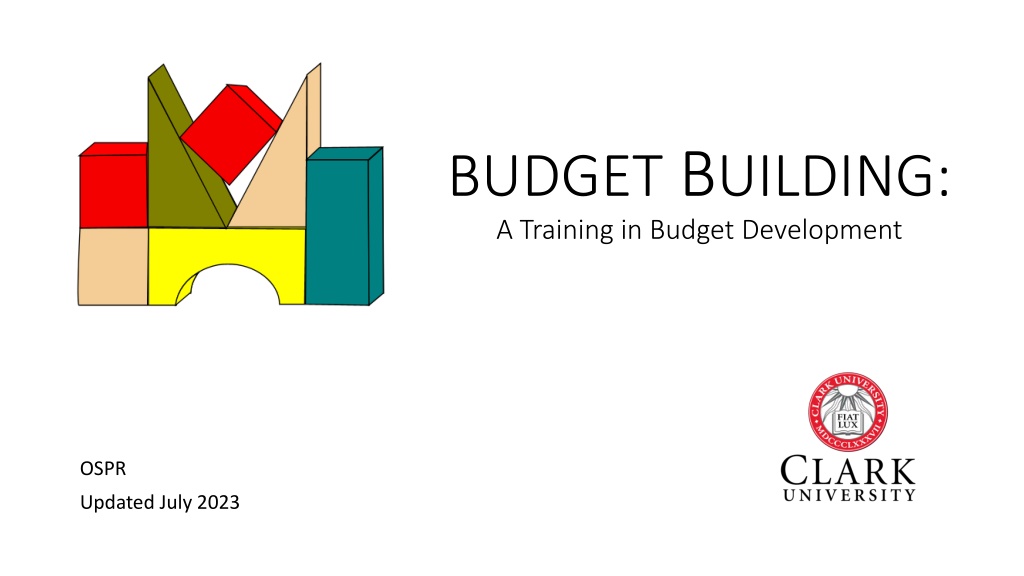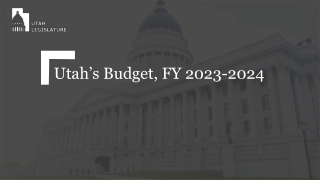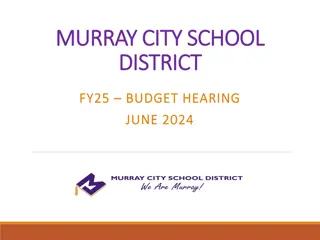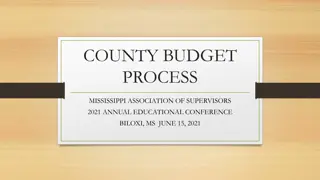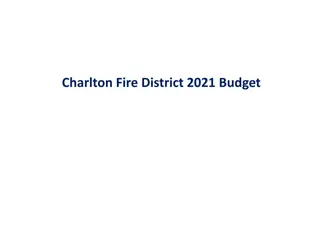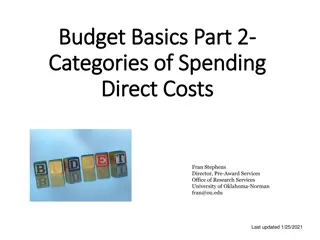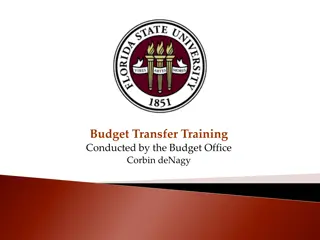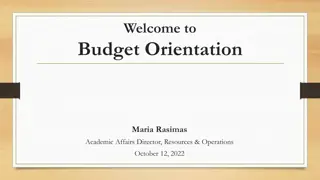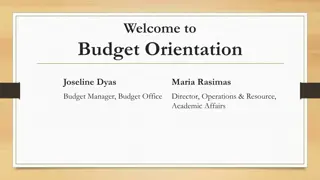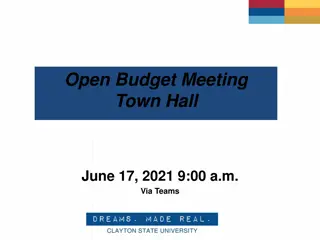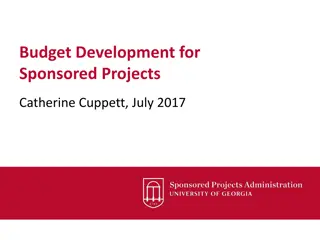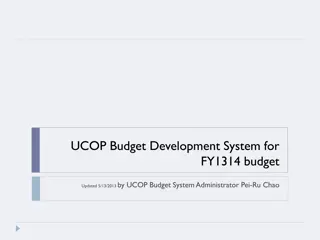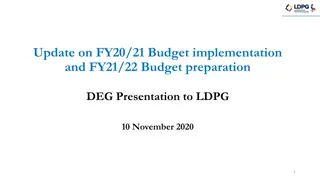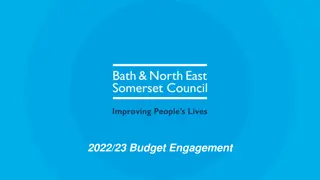Training in Budget Development: Key Principles and Regulations
This training focuses on budget building for projects, emphasizing the importance of accurate estimation, monitoring financial activities, and adhering to federal regulations. Learn about direct costs, assigning costs, and OMB Circular A-21 for educational institutions.
Download Presentation

Please find below an Image/Link to download the presentation.
The content on the website is provided AS IS for your information and personal use only. It may not be sold, licensed, or shared on other websites without obtaining consent from the author. Download presentation by click this link. If you encounter any issues during the download, it is possible that the publisher has removed the file from their server.
E N D
Presentation Transcript
BUDGET BUILDING: A Training in Budget Development OSPR Updated July 2023
Purpose The budget has two functions: 1. It estimates the cost of completing the objectives identified in the proposal. 2. It provides a means to monitor the project's financial activities over the life of the project.
Getting Started Follow instructions Know your limits Make sure that the costs are reasonable, allowable and allocable Questions to ask: oHow long will the project last? oWho is to be included in the project? oDoes the project require new supplies and/or equipment? oDoes the project require travel? oWill there be publishing costs? oWhat other costs does the proposed work require?
Direct Costs Direct costs are expenses that are attributable and chargeable to a particular sponsored project relatively easily and with a high degree of accuracy. Direct costs may include: Salaries and wages (including fringe) Materials and supplies Equipment -- over $5000 per item Travel Foreign and Domestic Consultants Subcontracts/Subawards Publication Costs Other direct costs (e.g., tuition, participant payments, graphic services, etc.)
Assigning a Cost Questions to ask when assigning a cost: Is it allowable per Federal Regulations and sponsor (government or private) terms? Is it reasonable? (What a prudent person would spend) Is it allocable? Is it a project-specific cost? Can it be assigned to the project relatively easily and with a high degree of accuracy? Is it treated consistently as direct charges under similar circumstances across campus?
Federal Regulations Federal Regulations OMB Circular A (relocated to 2 CFR 200) (relocated to 2 CFR 200) Cost Principles for Educational Institutions (OMB Circular A-21/2 CFR 200) establishes the principles for determining what costs are properly applicable to grants, contracts and other agreements with educational institutions. OMB Circular A- -21 21 Allowable Costs Unallowable Costs Direct expenses, such as salary, travel, project-related supplies, research assistants, publications, etc. Entertainment, air travel on a foreign carrier (under most circumstances), lobbying costs, alcoholic beverages, proposal expenses, subscriptions, memberships, etc. Also, an expense may be allowable, but not as a direct expense because it is included as part of the indirect cost calculation (e.g., general supplies) CIRCULAR A-21 Revised 05/10/04 | The White House
Salaries and Wages: Personnel Personnel include: Faculty, technicians, post-docs, graduate and undergraduate students, and other personnel required by the project. Grant pay for faculty is usually in the form of summer salary (SS). Most faculty have 9-month appointments giving them a possible 3 months time for additional compensation from other sources. Some funders may limit the amount of SS a PI can draw from a grant; e.g., NSF allows no more than 2 months SS from all grants combined. Requesting more than 2 months SS requires Dean of Research approval. Faculty 9-month appointment example: Salary 9 = 1 month: $81,000 9 = $9,000 Any anticipated salary increase from a promotion should be captured in the budget.
Salary Calculations Graduate RA salaries and time available are set by Clark. Undergraduate salaries should be consistent with departmental norms. For Post-Docs, check the industry norm, e.g., NIH salary schedule For new staff hires, check with Human Resources. Some funders request noting the percentage of effort of personnel on the grant. This is the percentage of the researcher s time dedicated to the project. E.g., 1/9th salary = 1 month = 11% effort If the project is multi-year, include a 3% annual increase each September.
Course Buy-out A course buy-out is a release from instruction granted to a PI by their department chair. A Provost-approved portion of the course buy-out funds the cost for a substitute instructor to cover the PI s course. A course buy-out is written into the grant budget at 1/8 of the PI s salary.
Fringe Benefits Fringe benefit packages vary and may include the costs of items such as: University and State retirement programs Health insurance Group life insurance, Social security Disability insurance, Workmen's compensation, and Unemployment compensation
Fringe Rates (Effective June 1, 2022) Fringe Rates (Effective June 1, 2022) Federally Funded Projects Non-Federally Funded Projects Personnel Full-time Tenure Track Faculty and Faculty summer salary 45.9% 48.7% Full-time Professors of Practice, Visitors, Post-Docs, Researchers, and Staff 26.1% 28.7% Part-time Faculty, Researchers, Post-Docs, Staff, Temporary Employees, and Faculty Summer Salary. 13.5% 13.5% PhD Graduate Students (Union positions, full academic year) 9.7% 9.7% Graduate and Undergraduate student employees - Applies to summer wages only 9.7% 9.7%
Equipment Supplies and Equipment is defined as a capital expenditure of over $5000. Supplies include items (unit cost under $5000), which are directly related and solely dedicated to the objectives of the project and are above and beyond office supplies provided by Clark, i.e., software, printing, postage, software and chemicals. Computers under $5,000 are considered supplies. But if software necessary to make them operable bring the cost over $5K, then the purchase is considered equipment.
Travel Travel costs (if allowable under sponsor guidelines) should be treated as a direct cost of the grant where such travel will provide direct scientific benefit to the program and is within specific sponsor restrictions. Reimbursement may be available for transportation (airfare, ground transportation), hotels, meals, telephone charges, and registration costs and fees. http://www.clarku.edu/policies/detailpolicy.cfm?pid=69 http://www.clarku.edu/offices/research/forms/travel.cfm
Consultants Consultants are individuals outside the university, whose expertise and skills will add value to the project. Consultants are never listed in the Salaries section of a proposal's budget. Consultant costs are generally expressed in per diem rates plus travel. Some sponsors, such as NSF, have per diem rate limits. To determine whether an individual qualifies as a consultant or temporary employee at Clark, complete and submit the checklist in this link: http://www.clarku.edu/intranet/apdocs/Independent%20contractor%20v ersus%20employee%20determination%20form.pdf
Subawards Subcontracts or Some proposals represent a collaboration of work by more than one institution and/or another organization doing a designated portion of the work. Where Clark is the prime applicant and awardee (if funded), these other collaborators or organizations/institutions will be subawardees or subcontractors. Costs of subaward or subcontracts are usually represented in the budget as a single line item and are usually accompanied by a separate budget The subaward/subcontract total budget includes both direct and indirect costs in the single line item on the prime institution's proposal budget. Most institutions require a subawardee institutional official's commitment (statement of work and budget) to the project before the prime institution s submission of the proposal.
Other Costs May include such items as: Participant payments Animal care per diems Publication charges Training fees
Cost Sharing or Matching When cost sharing or matching is required by a funding agency or offered by the University, the sources of a proposal's cost sharing or matching must be itemized and based upon current market prices. When projects are audited by a funding organization, cost sharing items as well as the expenditure of agency funds are commonly examined. There are basically two kinds of matching: cash and in-kind. All items that require the exchange of money are regarded as cash matching. These may include the costs of some faculty salary, supplies, or travel which are to be charged to a University operating account. Any items that do not involve the transfer of money are classified as in-kind matching, including any waived indirect costs and the use of specialized facilities not included in the University s indirect cost pool. Cost sharing or matching funds may come from a department, institute, Dean of Research or other appropriate university source. The source for the cost share or matching funds must be determined and their commitment to it documented prior to submission of the proposal. Some funders such as NSF prohibit voluntary cost sharing.
Indirect Costs Indirect costs are defined as "costs that are incurred for common or joint objectives and, therefore, cannot be identified readily and specifically with a particular sponsored project, instructional activity, or any other institutional activity." Indirect costs represent an average of expenses that cannot be charged directly to grants and contracts, such as: Facility-related costs, service-related costs, and administrative costs. Indirect costs are not a specific budget figure, but a calculation based upon a federally negotiated rate unique to Clark. Indirect Cost Rate (effective June 1, 2022): 50.3% (on-campus projects) 20.7% (off-campus projects)* *This rate is applicable only in very limited circumstances and should only be applied after consultation with OSPR
Calculation of Indirect Costs Calculation of Indirect Costs Modified Total Direct Cost (MTDC) are total direct costs minus the following*: Equipment and capital expenditures over $5000 per unit Tuition and fee remissions Participant payments Scholarships and fellowships paid directly to university students, but not as salaries and wages, when allowable under the terms of the award The portion of each subgrant, subcontract and subaward modification that is in excess of $25,000. Clark indirect costs are assessed on the first $25,000 only of each subaward. Some grants do not allow indirect costs applied to subcontracts. *Be sure to review application guidelines as they may vary as to what items may or may not be included in the indirect calculation.
Calculation of Indirect Costs Calculation of Indirect Costs (continued) Multiply the result (MTDC base) by the appropriate indirect cost rate 50.3% (on-campus projects); 20.7 % (off-campus projects). to find the indirect cost amount to include in your proposal budget.
Budget Justification Budget Justification A budget justification or budget narrative explains the need for each line item in the budget as well as shows the breakdown of calculations used to arrive at the amount in each line of the budget. Follow the same order as that in the itemized budget or sponsor's budget form, so reviewers can easily compare the two documents. Check to see if the sponsor limits the page length for the justification. Be sure everything in your budget and budget justification is referenced in the proposal description/narrative and be sure everything mentioned in your proposal description that would incur cost is explained in the budget and budget justification. Double-check what expenses the sponsor will and will not allow, Remember, all costs must be REASONABLE, ALLOWABLE, and ALLOCABLE
Contact Information Contact Information If you have questions, please contact: Lisa Gaudette, Director, OSPR lgaudette@clarku.edu 508-421-3835
